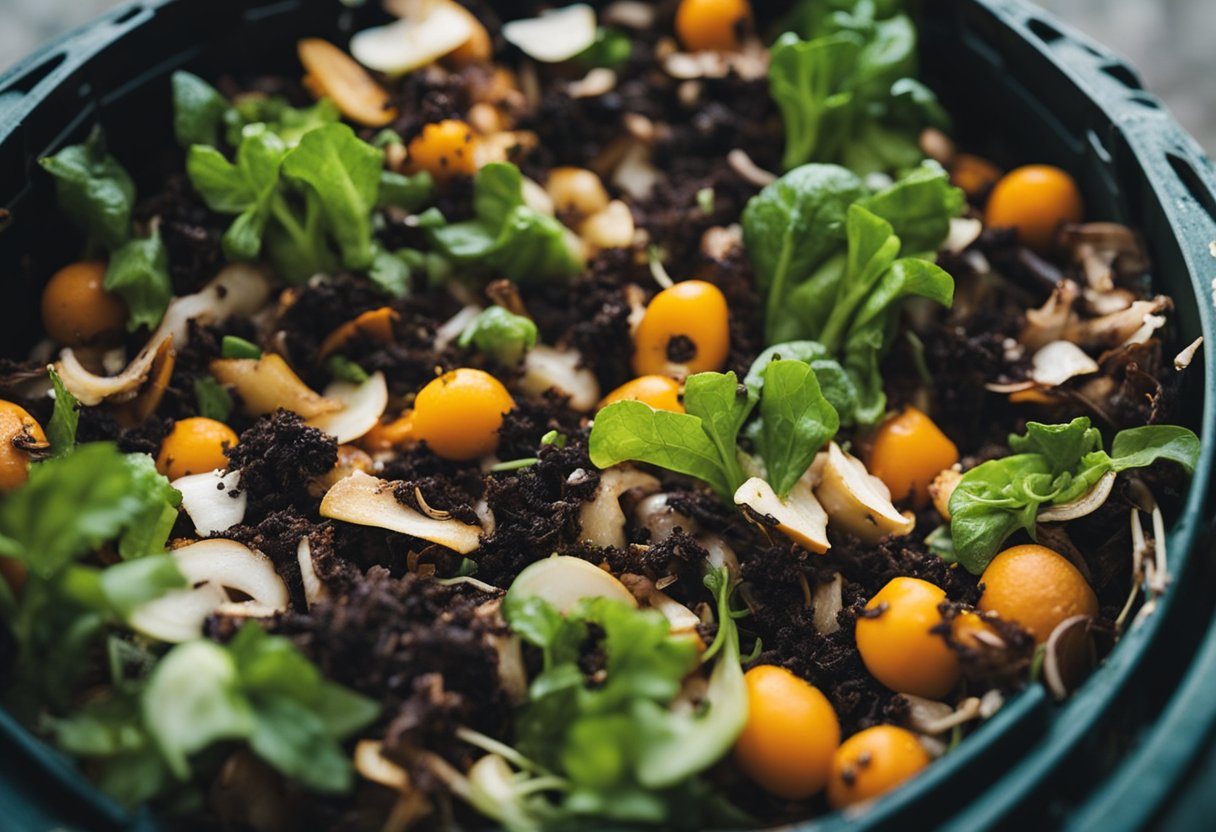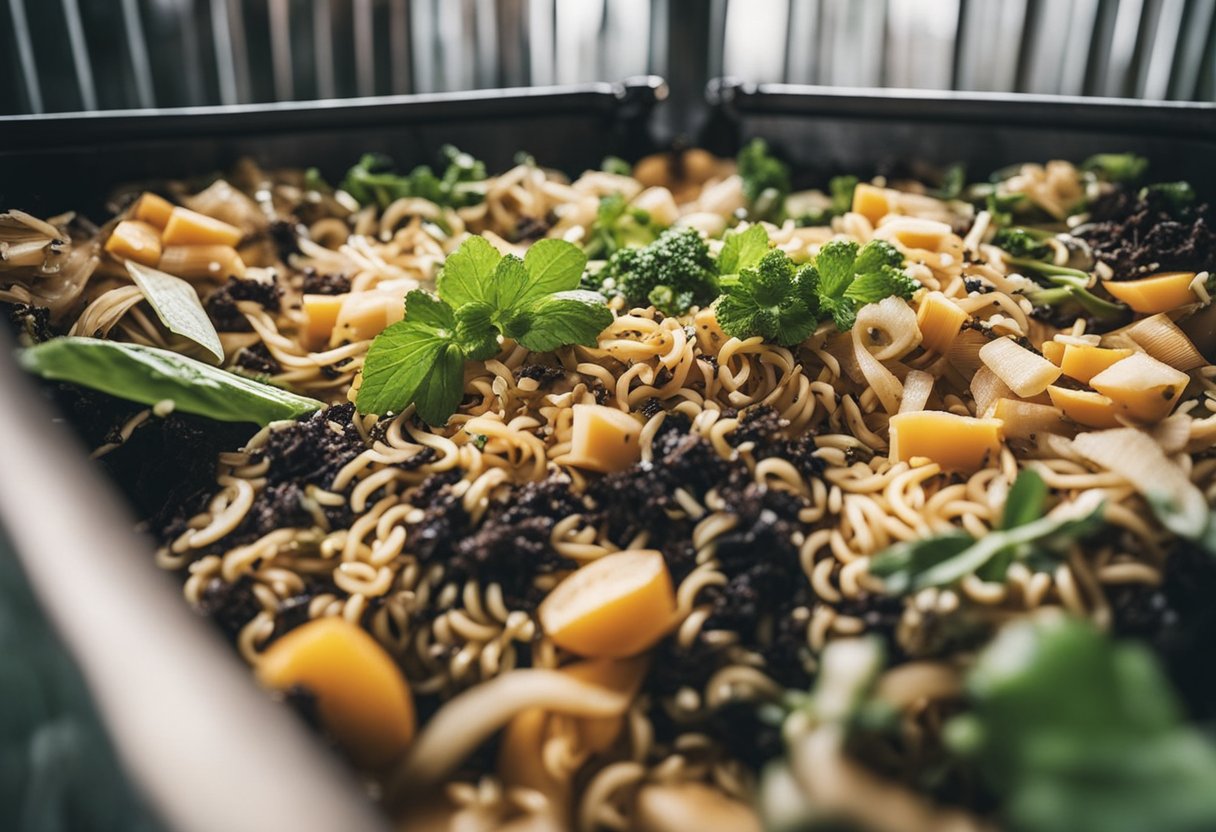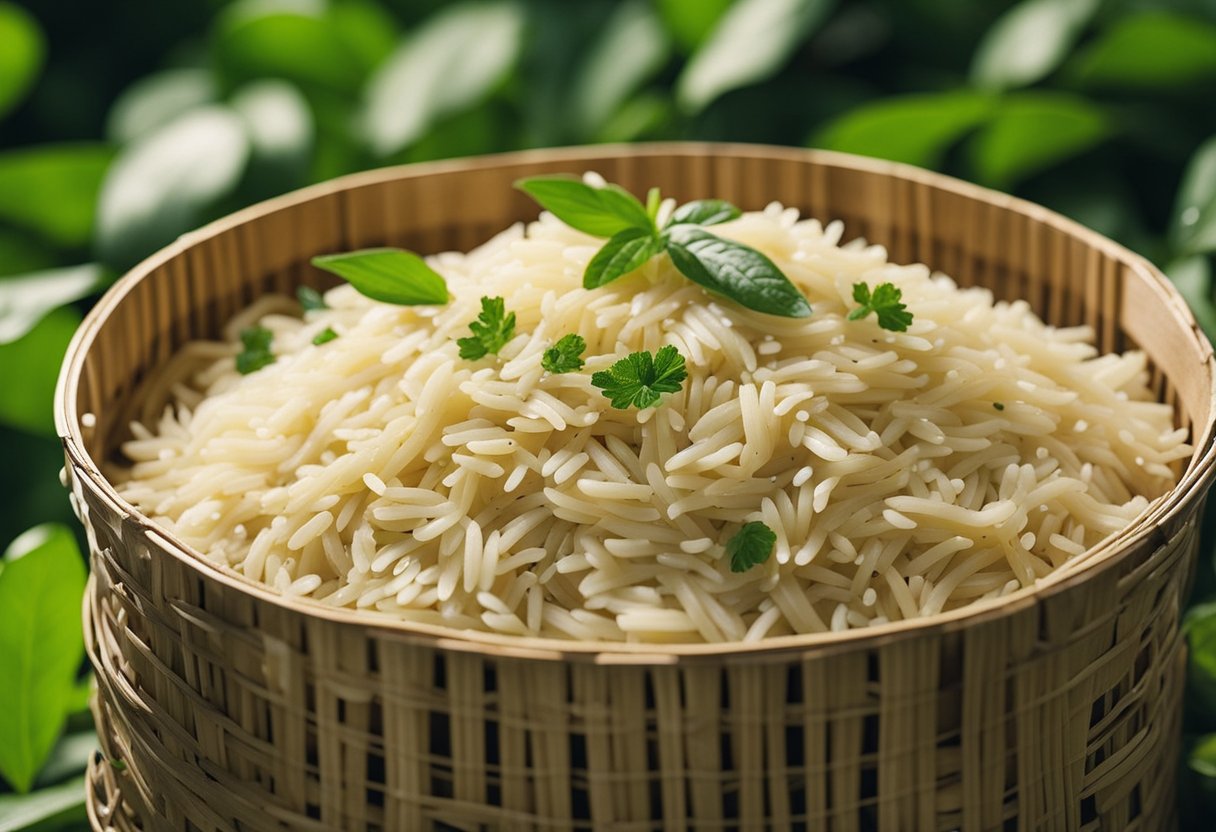As an Amazon Associate I earn from qualifying purchases.
At A Glance
Yes, you can compost rice and pasta. Both rice and pasta are organic materials that will decompose over time in a compost pile. They are categorized as “green” compost materials, providing necessary nitrogen to help break down “brown” materials like leaves and twigs.
Composting is an excellent way to reduce waste and create nutrient-rich soil for your garden. However, not all food waste is suitable for composting. Two common questions that often come up are whether you can compost rice and pasta. The short answer is yes, but there are some things to keep in mind.

Firstly, pasta and rice are carb-heavy foods that decompose like other edible foods. They are safe to add to your compost pile, but it’s best to add them sparingly to avoid attracting rodents and pests. You can add both cooked and raw rice, but it’s best to add them to a hot compost or a covered bin to speed up the decomposition process.
Secondly, while adding pasta and rice to your compost pile is generally safe, you should avoid adding any sauces or oils as they can attract unwanted pests and slow down the composting process. Additionally, avoid adding any meat or dairy products as they can create an unpleasant odor and attract pests. By following these simple guidelines, you can safely add rice and pasta to your compost pile and create nutrient-rich soil for your garden.
Understanding Composting
Composting is a natural process of decomposition that turns organic material into nutrient-rich soil. The process is driven by microorganisms, which break down the organic material into simpler compounds that can be used by plants as food. Composting requires the right balance of carbon, nitrogen, water, and air to be effective.
Carbon-rich materials, also known as “brown” materials, include things like dried leaves, straw, and wood chips. Nitrogen-rich materials, also known as “green” materials, include things like grass clippings, food scraps, and manure. A balance of both is needed for optimal composting.
Water is also important for composting, as it helps to keep the microorganisms alive and active. However, too much water can lead to a soggy, smelly mess, so it’s important to monitor the moisture content of the compost pile.
Temperature is another key factor in composting. Microorganisms work best in warm, moist environments, so it’s important to keep the compost pile at the right temperature. A temperature of 120-160°F is ideal for composting, as it kills off any harmful bacteria or pathogens.
Composting is a great way to reduce waste and create nutrient-rich soil for your garden. By using a mix of organic materials, including compostable items like rice and pasta, you can create a healthy, sustainable environment for your plants to thrive in.
Types of Compost Bins
When it comes to composting, there are different types of bins available on the market. The type of bin you choose will depend on your specific needs, budget, and the amount of space you have available. Here are some of the most common types of compost bins:
- Compost bin: This is the most basic type of compost bin. It is a simple container that you can use to collect your food scraps and yard waste. You can make your own compost bin using materials like wood, plastic, or metal.
- Covered bin: A covered bin is similar to a compost bin, but it has a lid that helps to keep out pests and other unwanted critters. This type of bin is great for outdoor use.
- Closed compost bin: A closed compost bin is designed to keep your compost contained and free from pests. It is typically made from plastic or metal and has a tight-fitting lid.
- Bokashi bin: A bokashi bin is a type of compost bin that uses a special type of bacteria to break down food scraps. It is a great option for those who want to compost indoors.
- Worm bin: A worm bin is a type of compost bin that uses worms to break down food scraps. It is a great option for those who want to compost indoors and have limited space.
Each type of compost bin has its own advantages and disadvantages. When choosing a compost bin, consider factors like the amount of space you have available, the type of materials you will be composting, and your budget. With the right compost bin, you can turn your food scraps and yard waste into nutrient-rich compost that can be used to fertilize your plants and garden.
What Can Be Composted

As a general rule, most organic materials can be composted. This includes fruit and vegetable scraps, leaves, coffee grounds, straw, fertilizer, dried leaves, grass clippings, eggshells, shredded newspaper, sawdust, food scraps, organic materials, fruit and vegetable peels, weeds, nutshells, wood chips, yard waste, stale bread, corn husks, non-glossy junk mail, paper egg cartons, wrapping paper, and yard trimmings.
However, there are some materials that should not be composted, including meat, dairy products, and bones. These items can attract pests and can also take longer to break down, which can lead to unpleasant odors.
When composting food scraps, it is important to avoid adding large amounts of any one type of material. For example, adding too many fruit peels can cause the compost to become too acidic, while adding too many grass clippings can cause the compost to become too wet and slimy.
To ensure that your compost is healthy and balanced, it is important to mix a variety of organic materials together. This will help to create a nutrient-rich compost that is perfect for fertilizing your garden or lawn.
Overall, composting is a great way to reduce waste and create a valuable resource for your garden. By following a few simple guidelines, you can create a healthy and productive compost pile that will benefit your garden for years to come.
Composting Rice and Pasta

I have researched whether rice and pasta can be composted, and the answer is yes, both can be composted. However, there are some things to consider before adding them to your compost pile.
Composting Rice
Rice is a great addition to your compost pile, whether it is cooked or uncooked. However, it is important to add rice sparingly to your pile. This is because rice can attract rodents and pests if added in large amounts. Additionally, stale leftover rice should not be added to your compost pile as it may contain harmful bacteria that can contaminate your compost.
When composting rice, it is best to add it to a hot compost pile to speed up the decomposition process. Adding rice to a covered bin can also help to keep pests away.
Composting Pasta
Pasta can also be composted, but it is important to note that pasta sauce should not be added to your compost pile. This is because pasta sauce can attract unwanted pests and create unpleasant odors in your compost pile.
When composting pasta, it is best to add it in small amounts to your compost pile. This will help to prevent the pasta from clumping together and slowing down the decomposition process. Additionally, it is best to break the pasta into small pieces before adding it to your compost pile.
Overall, rice and pasta can be great additions to your compost pile, but it is important to add them sparingly and follow the guidelines outlined above to prevent unwanted pests and odors in your compost.
Potential Risks and Precautions
As with any composting process, there are potential risks and precautions to consider when composting rice and pasta. Here are some of the most important ones:
Pests
Rice and pasta can attract pests such as rodents, ants, and flies if not properly stored or composted. To avoid this, make sure to keep your compost pile covered, add rice and pasta in small amounts, and mix them well with other compostable materials.
Meat and Fish
Composting meat and fish is generally not recommended as they can attract unwanted pests and release unpleasant odors. If you do decide to compost meat or fish, make sure to bury them deep in the compost pile and cover them with other materials to prevent pests from accessing them.
Moisture
Rice and pasta can retain moisture and create anaerobic conditions in the compost pile, which can lead to the growth of harmful bacteria and bad odors. To prevent this, make sure to mix rice and pasta with dry materials such as leaves, straw, or shredded paper to maintain proper moisture levels.
Pathogens
Rice and pasta can contain harmful bacteria such as E. coli and Salmonella, which can survive in the compost pile and contaminate your garden soil. To avoid this, make sure to cook rice and pasta thoroughly before composting and avoid composting any rice or pasta that has been left out at room temperature for more than two hours.
Caution with Pesticides
Rice and pasta that have been treated with pesticides should not be composted as the pesticides can contaminate your garden soil. If you are unsure if your rice or pasta has been treated with pesticides, it is best to err on the side of caution and avoid composting them.
Composting Mistakes
Composting mistakes such as adding too much rice or pasta at once, not mixing them with other materials, or not maintaining proper moisture levels can lead to unpleasant odors and slow down the composting process. To avoid these mistakes, make sure to follow proper composting guidelines and monitor your compost pile regularly.
Overall, composting rice and pasta can be a great way to reduce food waste and create nutrient-rich soil for your garden. By following these precautions and paying attention to potential risks, you can ensure a successful and safe composting process.
Hot Composting
When it comes to composting rice and pasta, hot composting is a great option. Hot composting is a process that involves creating a compost pile that generates heat as organic materials decompose. The heat generated by the pile speeds up the decomposition process, allowing you to create nutrient-rich compost in a matter of weeks.
To create a hot compost pile, you’ll need a mix of “green” and “brown” materials. Green materials include things like food waste, grass clippings, and coffee grounds, while brown materials include things like dried leaves, straw, and sawdust. You’ll also need to make sure your pile is moist enough, but not too wet.
Once you’ve gathered your materials, you’ll need to create a pile that is at least 3 feet tall and 3 feet wide. To ensure your pile is hot enough, you’ll need to monitor the temperature regularly. A hot compost pile should reach a temperature of at least 130-140°F. If your pile isn’t hot enough, you may need to add more green materials or turn the pile to add more oxygen.
Hot composting is a great way to compost rice and pasta because it can help break down these materials quickly. However, it’s important to note that rice and pasta should be added sparingly to your compost pile, as they can attract pests if not properly managed.
Overall, hot composting is a great option for those looking to compost rice and pasta. By following the right steps and monitoring your pile regularly, you can create nutrient-rich compost in a matter of weeks.
Vermicomposting
I have found that vermicomposting is an excellent way to compost organic waste, including rice and pasta. Vermicomposting is a process that uses worms to break down organic waste into nutrient-rich compost. The worms eat the waste and excrete castings, which are rich in nutrients and beneficial microorganisms.
One of the advantages of vermicomposting is that it can be done indoors, making it a great option for those who don’t have access to a yard or garden. All you need is a container, bedding material, and worms. You can purchase worms online or at a local garden center.
When it comes to composting rice and pasta, it’s important to note that cooked rice and pasta should be avoided as they can attract pests and rodents. However, uncooked rice and pasta can be added to a vermicomposting bin in small amounts. It’s best to break them up into small pieces to make it easier for the worms to consume.
Another thing to consider when composting rice and pasta is the carbon to nitrogen ratio. Rice and pasta are high in carbon, so it’s important to balance them out with nitrogen-rich materials such as fruit and vegetable scraps. A good rule of thumb is to aim for a ratio of 2:1 carbon to nitrogen.
In conclusion, vermicomposting is a great way to compost organic waste, including rice and pasta. By following a few simple guidelines, you can create nutrient-rich compost that will benefit your plants and garden.
Nutrient Value of Compost
As a compost material, rice and pasta are valuable sources of nutrients that can benefit your plants and garden. When added to compost piles, they break down into organic matter that is rich in minerals, such as nitrogen, phosphorus, and potassium. These nutrients are essential for plant growth and development, and they can help improve soil fertility by replenishing soil nutrients that have been depleted.
In addition to providing essential nutrients, compost can also help improve soil structure and water retention. Compost is rich in organic matter, which can help improve soil structure by increasing soil porosity and reducing soil compaction. This, in turn, can help improve water infiltration and retention, which can be especially important in areas with dry or sandy soils.
Compost can also help reduce the need for synthetic fertilizers and pesticides, which can be harmful to the environment and can contribute to soil degradation. By using compost as a natural fertilizer, you can reduce your reliance on synthetic chemicals and promote a more sustainable and eco-friendly approach to gardening.
Overall, composting rice and pasta can be a valuable way to recycle food waste and produce nutrient-rich organic matter that can benefit your garden and plants. With proper care and attention, composting can be a simple and effective way to improve soil fertility and promote healthy plant growth.
Frequently Asked Questions
As someone who composts regularly, I often get asked about what can and cannot be composted. Here are some frequently asked questions about composting rice and pasta:
Can you compost rice and pasta?
Yes, both rice and pasta can be composted. Rice is biodegradable and will break down in a compost pile, while pasta is also safe to compost, whether it’s cooked or uncooked. However, it’s important to keep in mind that both rice and pasta should be added sparingly to your compost pile to avoid attracting rodents and pests.
How should I add rice and pasta to my compost pile?
When adding rice and pasta to your compost pile, it’s best to break them up into smaller pieces to help them break down more quickly. If you’re adding cooked pasta, make sure to let it cool before adding it to your compost pile. You can also mix rice and pasta with other compostable materials like fruit and vegetable scraps, coffee grounds, and yard waste to help balance the nitrogen and carbon levels in your compost pile.
Can I compost rice and pasta with sauce or seasoning?
While it’s possible to compost rice and pasta with sauce or seasoning, it’s best to avoid doing so. The added oils, fats, and salts can slow down the composting process and attract unwanted pests. It’s best to stick to plain rice and pasta when adding them to your compost pile.
How long does it take for rice and pasta to compost?
The time it takes for rice and pasta to compost depends on a variety of factors, including the size of the pieces, the temperature of your compost pile, and the other materials you’re composting. In general, it can take several weeks to several months for rice and pasta to fully break down in a compost pile.
Can I use compost that contains rice and pasta in my garden?
Yes, you can use compost that contains rice and pasta in your garden. However, it’s important to make sure that the compost has fully broken down before using it to avoid attracting pests or spreading diseases. You can test the readiness of your compost by checking its temperature and texture. Compost that is ready to use will be dark, crumbly, and have a pleasant earthy smell.
